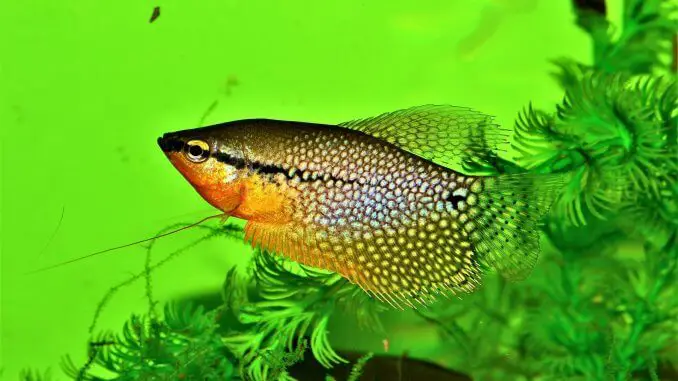
Gourami is a popular group of fish and one of the most popular varieties is the pearl.
They have a beautiful collection of white spots across their body and large delicate fins; all of this makes a very attractive fish for your aquarium.
It’s useful to have a little experience when keeping these fish. They can easily cause you to make some beginner mistakes, especially when you keep a breeding group.
This guide will teach you how to care for your pearl gourami, ideal tank mates, what size they should grow to, and much more…
TABLE OF CONTENTS
Pearl Gourami Fact & Overview
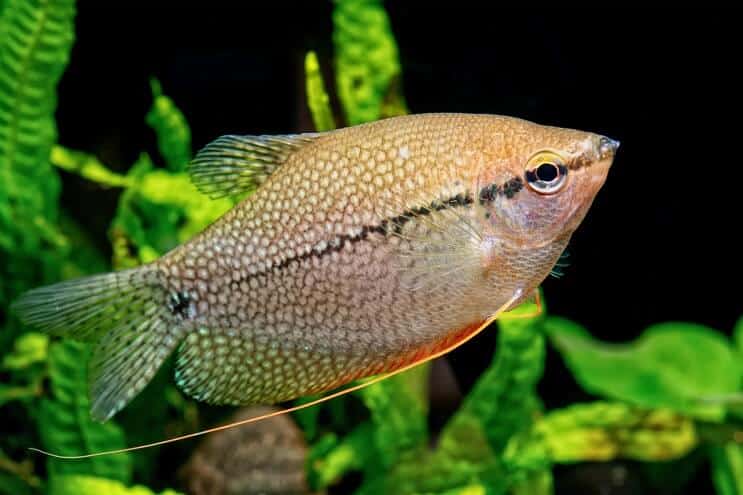
| Category | Rating |
| Care Level: | Medium |
| Temperament: | Peaceful |
| Color: | White spots with a black stripe along the middle |
| Lifespan: | Up to 5 years |
| Size: | 4-5 inches |
| Diet: | Omnivore |
| Family: | Osphronemidae |
| Minimum Tank Size: | 30 gallons |
| Tank Set-Up: | Freshwater and heavily planted |
| Compatibility: | Peaceful community |
Pearl gourami (Trichopodus leerii) are freshwater fish from the Osphronemidae family. This family includes lots of different gourami species, including the popular dwarf and kissing varieties.
Because of the patterns across their body, they are sometimes known as diamond, lace, or mosaic gourami, but these names are less common.
They’re native to Thailand, Malaysia, and Indonesia. Here they live in shallow tropical waters with plenty of vegetation and acidic water.
Nowadays you can find them all over the world because they’re bred in captivity for the fish keeping industry. These fish can sometimes be demanding so are best for those who have some experience under their belt.
With a little know-how they’re fairly easy to keep. This makes them popular for home aquariums, especially when combined with the intricate patterns that make them one of the most eye-catching tropical fish around.
You’ll find them in lots of different fish stores and you should be able to pick one up for around $5.
If you buy healthy fish, once settled into the tank they can live up to five years.
Typical Behavior
Pearl gourami share lots of behaviors with other gourami species. Most of their time will be spent swimming around the mid to upper levels of the tank.
Occasionally you’ll see them head to the surface, this is them heading up for oxygen. Whilst most fish breathe using their gills, some fish such as pearl gourami can also breathe through a labyrinth organ that takes oxygen directly from the air rather than water.
During spawning, they can become particularly aggressive. Males are the most aggressive; they’ll fight over females and scare off any fish that comes near their nest.
The rest of the time they are quite peaceful and shouldn’t bother tank mates.
Appearance
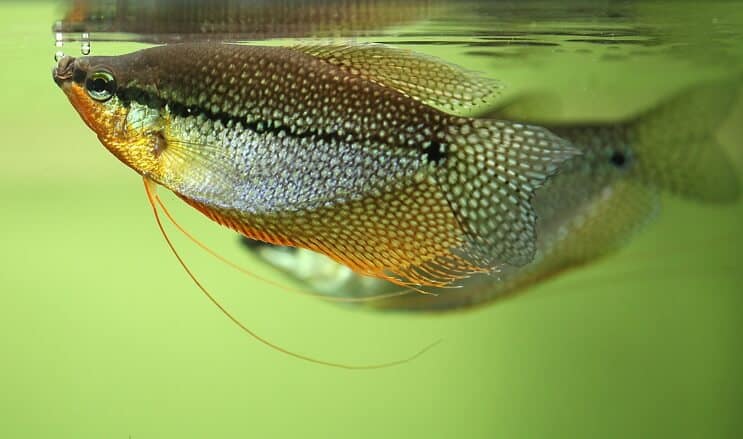
Their appearance is the main reason why pearl gourami is a sought-after species. It’s hard to deny their beauty. The body is covered in white, pearl-like spots, giving them their name; and a thin, black bar runs along their side.
The spots make them easily distinguishable from other gourami species, but their fins, size, and colors are different as well.
They have thin, large and wide fins. These give them an elegant and delicate look. Since their fins are so big, they are a prime target for fin-nipping fish, so keep them separated.
A pair of modified pelvic fins can be found hanging beneath them while they swim. These thin fins are nearly as long as the body. In terms of size, pearl gourami can grow to 4-5 inches.
It’s easy to tell males and females apart. Males develop a red breast as they mature, which gets brighter when mating and turns them into one of the most colorful fish around. Their dorsal fins are longer too.
Habitat and Tank Conditions
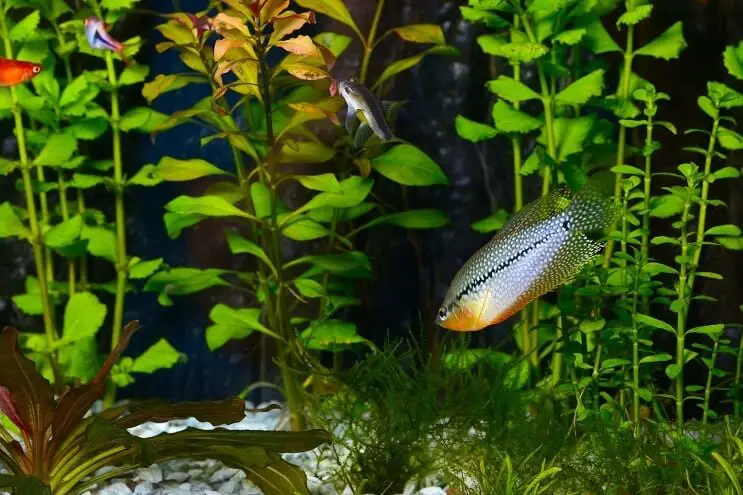
Pearl gourami live in the slow-moving freshwater in Asia. These include some lowland swamps, rivers, and lakes (the swamps, in particular, have quite acidic water).
These habitats share certain qualities which make them ideal for gourami. They tend to be quite shallow and have lots of plants and vegetation. This lets the gourami easily move from the safety of plants up to the surface for air.
Below the water would be a sandy substrate with rocks and logs sitting on the surface. They form caves and surfaces for algae to grow.
Tank Conditions
The best way to keep your gourami happy is to design your aquarium to be as close as possible to its natural environment. This lowers the risk of any health problems or hunger strikes.
Ideally, at the bottom of the tank, you’d have sand, since this is what they’d be used to in the wild. Fine-grained gravel can also be used as a substitute since the gourami will be higher up in the tank most of the time.
You will also need to add plants to the tank (java fern and anacharis are ideal). Live plants are best as they can be eaten and help to make the water cleaner.
Decorations are less crucial but can make the tank a bit more interesting. Your gourami might use any caves you make from time to time.
The next thing to consider is the water. Even though they naturally live in acidic water, those bred in captivity can tolerate a much wider pH range (6-8).
They’re a tropical species so the water needs to be heated to 77-82°F. The water’s hardness should be between 5-15dH.
Other than the heater, the only piece of equipment you’ll need is a filter to clean the water.
Some people like to add an air pump to circulate and oxygenate the water. This isn’t needed though as pearl gourami prefer calmer waters and get their oxygen from the air.
Make sure that there’s a space between the surface of the water and the lid of the aquarium to ensure they have access to air.
What Size Aquarium Do They Need?
Pearl gourami need at least a 30 gallon tank, especially if you want to keep a small group of them.
How Many Pearl Gourami Can Be Kept Per Gallon?
You need roughly 6 gallons for each pearl gourami to give them enough space. This is just a guideline though, it’s always best to understock rather than to overstock.
Tank Mates
Pearl gourami are generally peaceful fish, they make great additions to community aquariums. This means there are lots of possibilities when thinking about tank mates.
The best choices are small and peaceful fish like pearl danios or neon tetras. You can venture into larger fish as long as they don’t have a reputation to be territorial or aggressive.
Loaches and catfish are safe additions too. Most of their time will be at the bottom levels of the tank so they won’t come across the gourami too often; you should still choose peaceful species though, like Corydoras or yo-yo loaches.
Any large or overactive fish should be avoided. These will stress out the pearl gourami, causing them to hide away, pale in color, and may lead to health problems.
Fin-nippers (like tiger barbs) are another group to avoid. The large delicate fins will be an easy target.
As long as the fish are peaceful and not to large, they will make great tank mates for your Pearls, some other ideas include:
It’s easy to forget that your options as tank mates aren’t just restricted to fish; other creatures like shrimp or nerite snails can be added too. Not only do they look different, but they are also algae eaters (helping to keep your tank clean).
Keeping Pearl Gourami Together
You can keep these fish on their own, but they do much better in a group of around four or more. They’re social animals so you’ll see a lot more of their natural behaviors when keeping a shoal of them.
A group will emphasize their colors as well; watching a group of pearls moving around each other can be quite the spectacle.
The only thing you really need to consider when keep more than one is their sex. If the ratio of males to females is too high, they’ll start to fight. 1 male to 2-3 females is best. These numbers will help people hoping to breed them too.
Diet
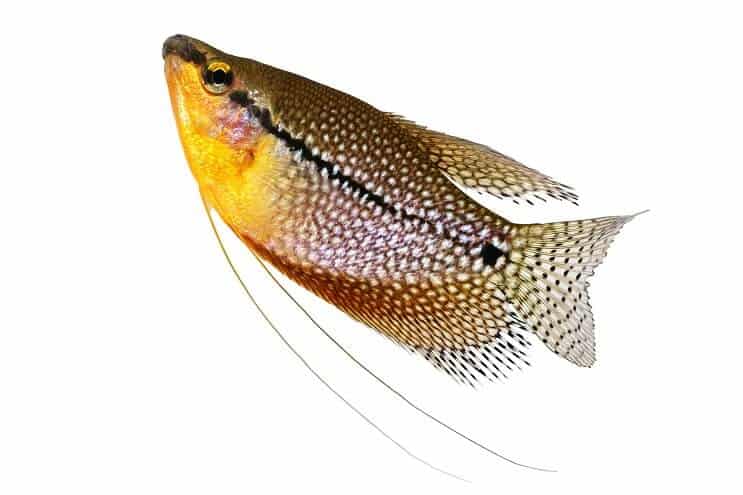
It’s important to pick a healthy diet for your fish. The diet you give your gourami can affect their growth and behaviors.
Pearl gourami aren’t picky eaters. They live an omnivorous lifestyle, letting them eat pretty much whatever comes their way.
In the wild, this might be larvae, small insects, eggs or algae. They can find food easily because they have aquatic plants all around them to eat if nothing else passes by.
You won’t struggle to replicate this for them in an aquarium. They will eat most fish foods you can get from pet stores, like flake, pellet, live and frozen foods. It just needs to be small enough to fit in their mouth.
Live foods are good because they encourage some different behaviors; the fish have to work for their meal. Examples of live foods are brine shrimp and glass worms.
Instead of fish foods, green vegetables can be added. If you cut up some small pieces, a simple vegetable like zucchini becomes a healthy way to vary up the diet.
Feed your fish small amounts 2-3 times a day so that you don’t overload their digestive system.
You only need to give them as much food as they can eat in a couple of minutes. Remove any leftover food from the tank so that it doesn’t decay and ruin the quality of the water.
Care
It’s always important to keep their tank clean by doing water changes every week or two and wiping down any excess algae.
A clean tank makes the disease much less likely, however, you can’t avoid diseases completely. All fish can get them and pearl gourami are no exception.
One of the most common problems for this species is fin rot. This is a bacterial infection that results in decay and discoloration of the fins.
The bacterium thrives when the water quality is poor and will more likely become an issue if the fins are already damaged. This is another reason to avoid fin-nippers. If you find that your fish do have fin rot, perform water changes more regularly.
Antibacterial medications can be added to the water to control the infection.
Fin rot is just one of numerous diseases pearl gourami might get. You need to watch your fish carefully to check for any signs of disease.
Other diseases your Gourami might get include:
- Ammonia Poisoning (red inflamed gills, gasping for air at the surface)
- Dropsy (Bloated, raised scales signifying a bacterial infection)
- Ich (Small white spots that look like bits of salt)
- Fish Fungus (cotton-like growths on body)
- Swim Bladder Disease (trouble staying upright)
The most common symptoms are reduced activity, discoloration, and going off their food. Look out for physical damage too, especially when spawning as the males may be fighting.
Breeding
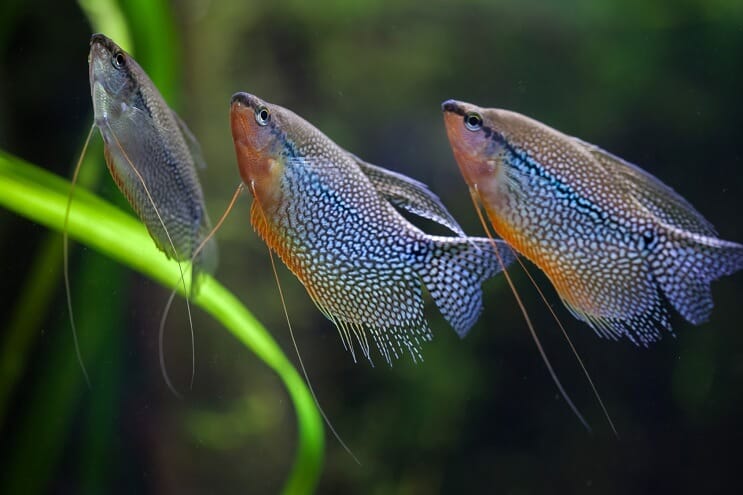
Pearl gourami are bubble nest builders. Males blow lots of bubbles when looking to mate, these float on the surface of the water.
A bubble nest is a collection of bubbles that the fish has blown to the surface of the water, the bubbles are coated in salivia to make them more durable. This nest provides a safe place to deposit the eggs.
In the wild, this would be done in the shallowest waters, in the hopes that any predators would be too big to reach the shallow water.
Once they’ve courted and spawned with a female the fertilized eggs will be released and float up into the bubble nest. It’s the male’s job to defend this nest against other fish looking for a snack.
The eggs hatch after a day or two and the fry should start to swim at five days old. Though adults have a labyrinth organ that lets them breathe air, fry has gills, so they need a good supply of oxygen in the water until they’re older.
It’s not too difficult to breed these fish at home and most of the things you can do to increase the chances of it happening to apply to most fish.
- First, you need both males and females in your tank. Pearl varieties are easy to sex so this shouldn’t be a problem. Males have a red breast and longer dorsal fins. Keep 1 male to 2-3 females. Too many males will mean a lot of fighting and not much spawning.
- Separate any fish that might eat the eggs/fry.
- Feed high quality foods.
- Raising the temperature is often effective in prompting spawning behaviors. In this case, you can go up to 82°F, but no higher.
- Finally, keep the tank clean to minimize stress.
Are Pearl Gourami Suitable for Your Aquarium?
If you already have, or are planning to start, a community aquarium, then pearl gourami would make a great addition. They’re one of the most popular gourami species, and just a popular freshwater fish in general.
Their colors and patterns will brighten up the tank and they should be easy to look after by anyone who has kept fish in the past.
You’ll need lots of plants to make them feel at home. Any tank mates you have should be small and peaceful, definitely no notorious fin-nippers allowed.
When these fish are kept healthy, you’ll enjoy watching them move around and interact with each other. If you’re looking for a new fish, they would be a great addition.
What are your experiences with pearl gourami? Let us know in the comments section below…

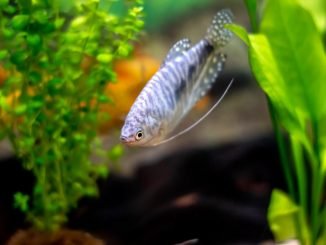
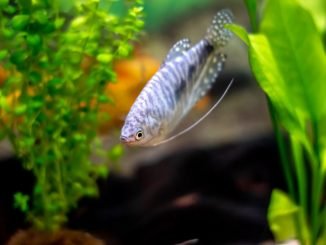
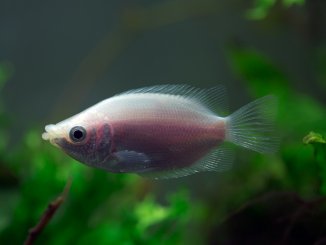
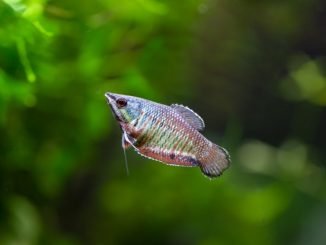
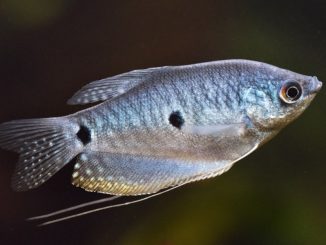
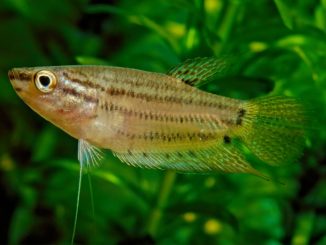
Leeri gourami is my favourite fish. I have biotope aquarium of 80 litre. I have community of mostly nano fish, such as harlequin and espei rasboras, tanychtis and kuhli loaches, as my main fish there are gouramies, marble and leeri. I am making it bitope – Asian aquarium and considering adding cherry shrimps. My fish lives in harmony. I have a lot of live plants too, mostly various cryptocorina species since they are survived through many years in my aquarium, also I have valisneria and Java fern. I have snails MTS and Helena which came with plants by accident but they are good addition I would say. My question is, would cherry shrimp survive in my semmy-nano community aquarium?
Hi Vladimir, some of those fish will most definitely eat juvenile Cherry Shrimp, and they’re likely to carry on hunting them as they the shrimp grow too. Thanks, Robert
Your aquarium does sound FAR too small for pearl gouramis, though…
I’m restarting a South-Asian biotope tank and was planning on getting gouramis, but since I’ve never had any pearls, I asked other people about compability with my intended 180 liter tank.
I was advised by several people that my 180 liter tank was too small for a group of three pearls, when I was hesitant whether the tank would be sufficiently large for pearls if other fish were present…
(Would be housed with groups of lambchop rasboras, cherry barbs, kuhlii and rosy loaches). So I decided for honeys instead.
In a 100 liter tank I probably wouldn’t house any gouramis larger than a pair of sparkling gouramis or a small group of honey gouramis. Pearls are fairly large fish.
My intended 180 tank has some issues so I’m planning to buy a 240 liter for the South-Asian community above–and then I might change my mind and go for pearls, since I feel okay about putting three or four pearls in a 240 liter together with aboutish 15 lambchops, 10+ cherry barbs, 10+ kuhlii and 10+ rosy loaches.
I will be getting a secret certain pair of demacrat?✊? african cichlids 3 male pearl gouramis with houses for hiding and 1 single male republican? red longear named {texas}
At what size does the fish develope the red breast?
would it be ok if I had a pearl gourami and a dwarf gourami in a 6.7 gallon aquarium?
You would only house a pair of sparkling gouramis in a 26 galon tank ?
You can keep a group of Pearls in a 40 breeder with some dither fish no problems at all.
Great article Robert and very helpful. Just one thing – the chart on the page has the specs for some kind of blue and green cichlid that is aggressive and reaches 12” in size and lives for 7-10 years and requires a 75 g tank for a pair. That must be incorrect based on the rest of the article.
Hi Melanie, thank you for bringing this to our attention! We’ve updated the table with the correct information. We’re glad you enjoyed the article :-)
-Robert